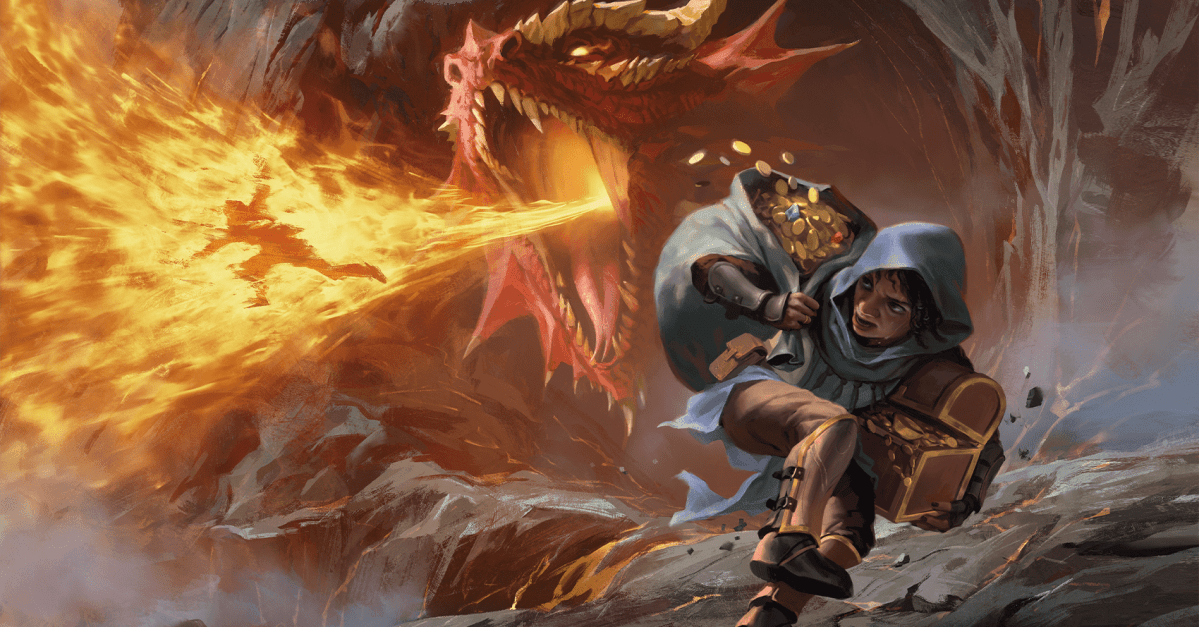Rogue is one of the 12 classes you can choose from in Dungeons & Dragons 2024’s revised Player’s Handbook (previously known as One D&D, 5.5e, and a few other names). Rogues are sneakiness-focused characters, and their primary Ability is Dexterity.
Before we get started, a quick disclaimer: There’s no “best” anything in D&D. Classes tend to be well-balanced when it comes to damage output. More importantly, though, D&D is a roleplaying game as well as a combat game, so there’s more to it than stabbing monsters. And that diversity of situations — from picking locks to punting kobolds to seducing dragons — means “best” is entirely subjective.
Our D&D Player’s Handbook (2024) Rogue guide will walk you through the class and talk about some of the changes from D&D 5e.
Is Rogue the best class for you in D&D?
Rogues are equal parts sneaky and stabby, and there’s actually a bit of work that goes into making sure you’re getting the most out of your character. Finding ways to get your Sneak Attack damage with every attack means you’ll be moving around a lot and playing across the entire battlefield. Outside of combat, Rogues are a party’s go-to for picking locks and finding traps, and their skill proficiencies tend to make them good talkers (or liars).
Inspiration for your Rogue
There are so many famous Rogue archetypes in fiction that it can be easy to just stick to the dagger-brandishing, cape wearing, hunched-over goober you see on the cover of fantasy novels everywhere. There’s nothing wrong with that kind of hero, of course, but there’s a wide world of inspiration for you to draw from:
- The scoundrel is an obvious pull, and you can take inspiration from characters like Han Solo. While that might conjure the image of a “down on their luck, always in-debt” kind of character, you could do a fun twist on it by pulling from Han’s good buddy Lando Calrissian, and show how the rich and successful can still cling to their thieving ways.
- The dark and quiet type of rogue conjures up Strider, AKA Aragorn’s “ranger” name in Lord of the Rings. This can be more of that classic fantasy Rogue, who listens rather than speaks and brews in the corner of dark taverns with a stiff drink and a lot of stories to tell.
- There’s also the noble rogue, who uses dastardly means of subterfuge to further their goals of helping others. Think about Robin Hood, Zorro, or even the Dread Pirate Roberts from Princess Bride.These are all swashbuckling, sword-fighting heroes who break the law but have hearts of gold.
- The trained professional is a fun twist on the classic fantasy rogue, and allows you to draw inspiration from characters like the smooth-talking James Bond to the devastatingly quiet John Wick. These are Rogues that are very good at what they do, whose meer mention strikes fear into the hearts of their enemies.
What’s new for Rogues in One D&D?
No matter what Class you end up picking, One D&D changes the way characters are created. Specifically, the Background you choose now comes with an Ability Score improvement (one point each in three Abilities, or two points in one Ability and one point in another). In addition, every character gets an Origin Feat. We’ll deal with both of those changes below.
One D&D’s Rogue class gets the weapon mastery class feature. You get to choose two weapons with which to use the Mastery Property when you attack.
At level 3, Rogues get the Steady Aim feature. This bonus action gives you advantage on your next attack during that turn (remember that you can use your bonus action at any point), provided you haven’t moved yet and also reduces your movement to 0. This is specifically useful for guaranteeing a Sneak Attack.
Certain actions — like Cunning Strike’s Poison or Trip at level 5 — have a Sneak Attack cost associated with them. Each of those cost 1d6 of your Sneak Attack damage, meaning you remove them from your Sneak Attack pool before you roll them (making it 2d6 at level 5) and then trigger the effect after your attack.
Rogue class features overview
- Primary Ability: Dexterity
- Hit Point Die: d8 per level
- Saving Throw Proficiencies: Dexterity and Intelligence
- Skill proficiencies: 4 of: Acrobatics Athletics, Deception, Insight, Intimidation, Investigation, Perception, Persuasion, Sleight of Hand, Stealth
- Weapon Proficiencies: Simple, Martial with Finesse or Light property
- Armor Training: Light
Expertise grants you Expertise in two of the skills you’re already proficient in, which allows you to essentially double your proficiency bonus for a given skill. This level 1 class feature is not unique to Rogues, but it can be used to emphasize either combat or social skills. From the get-go, Rogues can become an expert in two additional skills again at level six.
This feature is extremely potent, and just factors into the “rogues are never OK at anything, they’re either incredible or terrible” mentality.
Sneak attack is the way to do damage as a Rogue, and “how do I prepare to sneak attack this target next turn” should go through your head every time you make a move.
Basically, you’re able to deal 1d6 bonus damage once per turn to a single creature if you have Advantage on your attack roll and you’re using a Finesse (like daggers or rapiers) or a Ranged weapon. The caveat to that is that you can also sneak attack if you have any ally within five feet of the target.
Just keep in mind that you must declare your intent to sneak attack to your DM. So when you attack with advantage, say you’re spending your sneak attack and roll that bonus damage dice!
Thieves’ Cant is basically the language of the streets in D&D. You’ll be able to communicate secretly with others who know Thieves’ Cant, like people in the local thieves guild, street toughs, vagabonds, etc. If you walk into a shady area or are talking to a suspicious person, ask your DM if you can communicate with them in Thieves’ Cant to either keep secrets from your party or just add some fun flavor to the scene. Maybe the NPC will even trust you more!
You also are able to learn an additional language of your choice for free.
You are well-trained in two weapon types, allowing you to use the mastery properties of each. You’re able to change out which two weapons you have mastery with each Long Rest.
How to build an effective Rogue
When you first make your character, you’ll need to assign your attribute points. For most non-magical Rogues, here’s your priority list:
- Dexterity
- Constitution
- Wisdom
- Charisma
- Intelligence
- Strength
If you’re an Arcane Trickster Rogue, you’ll want to prioritize Intelligence after Dexterity in order to increase your spellcasting ability, but the rest of the order doesn’t change.
Best Rogue Backgrounds and Origin Feats
Backgrounds in One D&D are a way to codify your character’s personal history into their stats. Backgrounds give you a bump to your stats, a couple of skills, tool proficiencies, and an Origin Feat.
For Rogues, let’s start with anything that lets you bump Dexterity — Artisan, Charlatan, Criminal, Entertainer, Guide, Sailor, Scribe, Soldier, Wayfarer. Beyond that, it depends on what kind of Rogue you want to make.
- If you want to be good at lying, you’ll want to also bump Charisma with Charlatan, Entertainer, or Wayfarer
- If you want to be good at investigating, you’ll want Intelligence with Artisan, Criminal, or Scribe
Criminal is a good fallback if you can’t decide. The Alert Origin Feat you get will bump up your Initiative, and it gets you proficiency in Sleight of Hand and Stealth — opening up more options for your Class-granted skill proficiencies.
You don’t pick a Rogue subclass until Level 3, but you’ll want to think about where you’re heading pretty early on — especially in terms of Background and Origin Feat (above).
The Arcane Trickster is one of the most powerful subclasses in the game, as it allows you to combine the high damage of a dagger or crossbow-wielding Rogue with the utility of a Wizard.
At level 3, you gain access to spellcasting, including three Cantrips and some spell slots. Notably, this gives you access to Mage Hand, which allows you to pilfer pockets magically and from a distance, as well as any number of interesting things.
You’ll continue to gain spell slots and access to more powerful spells as you grow in level. Eventually, at level 17, you’ll be able to steal spells from other spellcasters. You can then cast that spell for the next 8 hours.
Assassin is about what you’d think it is, and is all about dealing massive damage before your targets even know you’re there.
Your main tool as an assassin is … Assassinate, which gives you Advantage on all Initiative rolls and you’re able to deal bonus damage during the first round of combat.
At level 17, you can use Death Strike to deal double damage on your first sneak attack of a combat.
The Soulknife trades out normal blades for special psychic blades and dice. You can also do some pretty wild stuff with these energy dice you get — like reroll an ability check — but the coolest feature here are the knives themselves. Instead of using traditional weapons, you can manifest physic blades in your hands when you attack, which deal damage and then disappear as if they were never there.
If that’s not cool enough, at level 9 you gain the ability to throw one of your Psionic blades and then teleport to it.
The Thief is probably the most well-known archetype of the Rogue, and is focused more on the out of combat skills that come with being a Rogue. You’re able to climb, and jump very efficiently, and you can steal stuff easier than the average character.
At level 17, you’re able to move so quickly that you get a second turn on the first round of any combat, allowing you to dish out a lot of damage or complete an objective before most characters are able to even move once.







